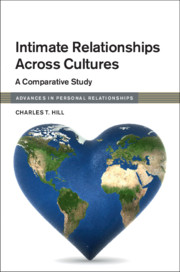Book contents
- Intimate Relationships Across Cultures
- Advances in Personal Relationships
- Intimate Relationships Across Cultures
- Copyright page
- Epigraph
- Contents
- Figures
- Tables
- Spotlights
- Collaborators
- Foreword
- Acknowledgments
- Introduction: Why Was This Book Written?
- 1 How Do We Know What Matters in Intimate Relationships?
- 2 Why Do People Seek Intimate Relationships?
- 3 How Are Intimate Partners Selected?
- 4 What Is Love and How Is Intimacy Expressed?
- 5 How Do Sexual Attitudes and Behaviors Matter?
- 6 What Are the Dynamics of Exchange and Power?
- 7 How Do Couples Cope with Conflict?
- 8 How Do External Factors Matter in Intimate Relationships?
- 9 How Do Intimate Relationships Relate to Well-Being?
- 10 How Do the Predictions Combine in Comprehensive Models?
- 11 How Much Do the Levels of Factors Vary?
- 12 What Are the Implications of the Study?
- 13 How Might the Findings Apply to Other Social Relationships?
- Epilogue: What Future Research Is Needed?
- Glossary of Statistical Terms
- Boston Couples Study Publications
- References
- Index
10 - How Do the Predictions Combine in Comprehensive Models?
Published online by Cambridge University Press: 21 June 2019
- Intimate Relationships Across Cultures
- Advances in Personal Relationships
- Intimate Relationships Across Cultures
- Copyright page
- Epigraph
- Contents
- Figures
- Tables
- Spotlights
- Collaborators
- Foreword
- Acknowledgments
- Introduction: Why Was This Book Written?
- 1 How Do We Know What Matters in Intimate Relationships?
- 2 Why Do People Seek Intimate Relationships?
- 3 How Are Intimate Partners Selected?
- 4 What Is Love and How Is Intimacy Expressed?
- 5 How Do Sexual Attitudes and Behaviors Matter?
- 6 What Are the Dynamics of Exchange and Power?
- 7 How Do Couples Cope with Conflict?
- 8 How Do External Factors Matter in Intimate Relationships?
- 9 How Do Intimate Relationships Relate to Well-Being?
- 10 How Do the Predictions Combine in Comprehensive Models?
- 11 How Much Do the Levels of Factors Vary?
- 12 What Are the Implications of the Study?
- 13 How Might the Findings Apply to Other Social Relationships?
- Epilogue: What Future Research Is Needed?
- Glossary of Statistical Terms
- Boston Couples Study Publications
- References
- Index
Summary
To capture the complex predictions from the previous chapters, these predictions are summarized in this chapter and combined to create a Comprehensive Partner Model and a Comprehensive Commitment Model. The chapter discusses how well these models predict, what is surprising about the findings, and why the same factors make similar predictions across relationship types and cultural regions.
Chapter 1 noted that when predictor factors are correlated with each other, what they predict in common may be accounted for by the factor with the strongest effect, leaving little additional variance to be accounted for by other factors correlated with it. This may be reflected in low standardized regression coefficients for the other factors, even if they have sizable correlations with the dependent variable. The strongest predictor factors that are correlated with other predictor factors and capture what they predict in common, or have additional effects beyond what they have in common, are called Central Factors in this book.
- Type
- Chapter
- Information
- Intimate Relationships across CulturesA Comparative Study, pp. 173 - 182Publisher: Cambridge University PressPrint publication year: 2019

